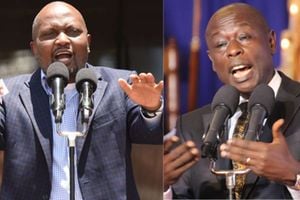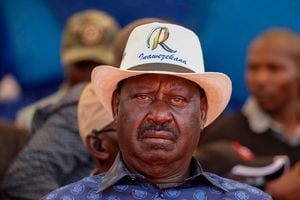Switching off fake phones a tough call

Photo/FILE
Safaricom public policy analysis manager Mercy Ndegwa holds some of the fake Nokia and Samsung phones during a media workshop.
As the deadline to switch off fake mobile handsets in the country draws near, the process is now embroiled in twists and turns, threatening to throw the industry in disarray.
Behind the public support to the cause by the Communications Commission of Kenya lies a dispute which industry players are struggling to solve.
It has also emerged that none of the networks have the capacity to automatically switch off a counterfeit handset.
Doing so will have to be done manually, or the telecos will be forced to upgrade their networks, with unconfirmed reports saying this would cost each operator about 50,000 euros, or Sh6.7 million.
In an industry characterised by loss making operations, but for one operator, the amount, though modest, could make them question the need to spend extra cash with no returns expected.
This comes on the back of the recent $10 million (about Sh990 million) move to install a Mobile Number Portability system, which has interested about 30,000 subscribers only.
Just semantics
What might appear to be just semantics is threatening to throw out plans for the switch off. At the centre of these meetings currently under way at the CCK headquarters on Wayaiki Way, Nairobi, is the definition of the word “counterfeit”.
According to the regulator, a counterfeit mobile phone handset is one without the unique identifier (IMEI), or one whose IMEI structure is not compliant with the GSMA standard.
“This definition has been agreed upon by all stakeholders and we have not received any objection to it,” says Mr Christopher Wambua, assistant public relations manager at the commission.
While the regulator’s definition puts more weight on the IMEI, there are several other elements, like brand names, that it also adds to its register of what a fake handset is.
The International Mobile Equipment Identity (IMEI) is a 15 digit globally assigned to all mobile phones upon production. It can be displayed on most mobile handsets by dialling *#06#.
It has so far been cited across the divide as a key factor in identifying devices and can be used in most cases to stop a stolen phone from accessing any network.
However, sections of the meeting said, albeit mutedly, that this does not entirely capture the spirit and intent of the counterfeit law.
“The regulator is still working with the operators to ensure that the definition is in line with global standards, and also encompasses all the quality of service perimeters,” said Ms Angela Ng’ang’a-Mumo, head of corporate communications, Telkom Kenya.
According to Mr Henry Maina, a director of Article 19, Kenya, a human rights organisation, no universal definition has been put on the table.
Globally, he explains, each country sets its own standards and tests all mobile phones on that basis.
“Kenya has not set such standards and neither does the Kenya Bureau of Standards have the capacity to test mobile telephones. We are relying on approval standards from other jurisdictions,” he said.
Plans to switch off counterfeit mobile phones have dominated debate among operators over the past two months.
Initially, the regulator had intended to achieve this by September 30, but an appeal by providers led to a stay of the order.
However, at a joint meeting held during the month, a deal was reached to wipe out this class of handsets by the end of the year.
The statement by the regulator then further said a technical committee would be in place to oversee the switch off.
It is at this meeting that, sources indicate, the technicality of the definition arose. The meeting also wondered how best to classify a fake handset.
While this technicality could well be within the logic of what to wipe out, a new angle is emerging.
In a letter the Smart Company is privy too, the regulator in May requested operators to provide information to their subscribers on the impending switch off.
Additionally, they were expected to make internal arrangements to carry out the phasing out of illegal phones, wrote suspended director general Charles Njoroge.
“If the operators truly cared about consumers’ security, interests and welfare, they would have then (in May) alerted the public of the impending directive to save us billions of shillings on “fakes” or what-have-you gadgets,” says Mr Alex Gakuru, chairman, ICT Consumers Association of Kenya.
With more than 25 million subscribers in Kenya, the mobile handset market is thriving. This has occasioned a number of handset players to jostle for clients.
As a result, an estimated three million handsets, whose IMEI numbers cannot be recognised, have found their way to the networks. It is these and the new ones being activated that the regulator is seeking to put off air.
From the look of things, however, the exercise is facing a tough call, although players are exuding confidence that it will beat the set time frames.
A tentative date has been suggested as December 31, when it is hoped that all suspect handsets will be disabled.
“It is too simplistic to direct mobile operators to switch off counterfeit devices without dealing with the real problem.
“We hope that all these agencies will crack down on importers of these counterfeit devices to ensure that the consumer is not exploited,” says Mr Nzioka Waita, corporate affairs director, Safaricom.
While a solution to the problem has been in the works, government agencies have exhibited a lethargic approach to dealing with the issue.
It can be remembered that the Anti-Counterfeit Agency initially said it had not received any formal complaint on these types of phones being in the market.
At the first status meeting held on September 9, the commission invited a number of State agencies to the meeting.
Present were the Kenya Bureau of Standards, Anti-Counterfeit Agency, Office of the President, Kenya Police, the Kenya Revenue Authority and the National Security Intelligence Services.
“The CCK, ACA, the police, as well as all relevant authorities and concerned parties, including vendors and operators, must work together to eradicate this problem,” says Mr Waita.
Currently, counterfeits are estimated to cost the exchequer some Sh3.2 billion annually in conservative figures.
This is money lost in unpaid taxes and licences by dealers who do not register these phones for type approval by the CCK.
In an ideal situation, the regulator is supposed to approve all handsets sold in Kenya.
But even with this requirement, some unscrupulous traders continue to sell fake phones to unsuspecting consumers across the country.
The outcry has, however, come from concerned consumers who have pleaded innocence in the fight against counterfeit phones.
A number of them have heaped the blame on the high costs of “genuine” handsets in their quest to keep up with the changing communication world.
But in taking this action, Mr Maina says that it would be punishing the victims rather than the real reasons behind the problem.
He adds, that under international freedom of expression standards, freedom of expression can be restricted only under very narrow conditions.
In what Article 19 calls a “three-part” test, developed by the Human Rights Committee for assessing the legitimacy of restrictions, this can happen only if the interference is in accordance with a law.
Additionally, it can happen if it is a legally sanctioned restriction, which must protect or promote an aim deemed legitimate in international law and, lastly, the restriction must be necessary for the protection or promotion of the legitimate aim.
“The switch off is against consumer rights as provided for in Article 46 of the Constitution. It also infringes on the right to access information (Article 35),” says Mr Maina.




